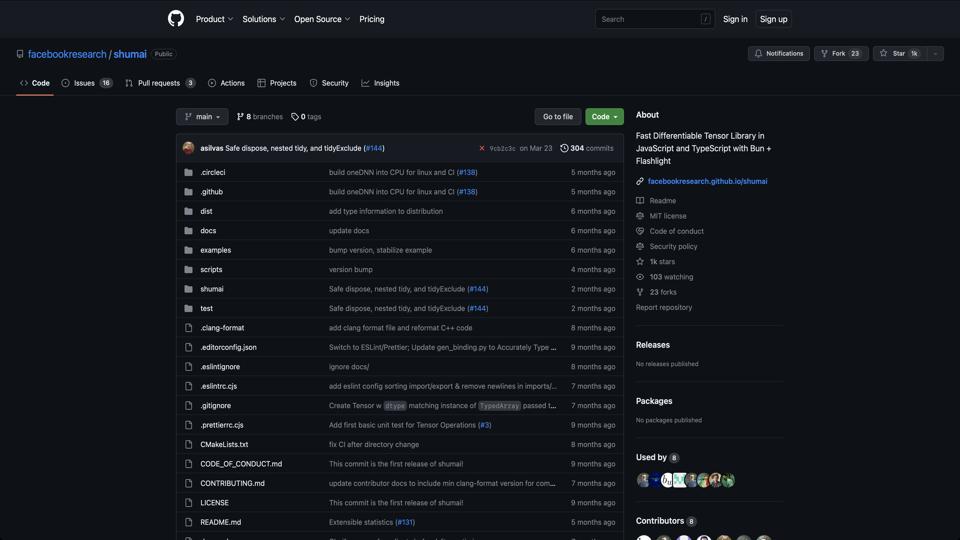Shumai (Meta)
Overview of Shumai
Shumai is an open-source tensor library developed by Facebook Research, designed for JavaScript and TypeScript environments. It provides a flexible framework for building and running machine learning models, drawing inspiration from PyTorch. The library emphasizes ease of use, performance, and integration with web technologies, making it suitable for browser-based ML applications, Node.js scripts, and even edge computing. You can find the official repository here.
Key Features
- Tensor Operations: Supports a wide range of tensor manipulations, including creation, arithmetic operations, reductions, and broadcasting, similar to NumPy or PyTorch tensors.
- Automatic Differentiation: Built-in autograd system for computing gradients, enabling easy training of neural networks.
- Model Building: Tools for defining layers, optimizers, and loss functions to construct and train models directly in JavaScript.
- Performance Optimizations: Leverages WebAssembly and GPU acceleration via WebGPU for faster computations in the browser.
- Cross-Platform Compatibility: Works seamlessly in browsers, Node.js, and even on devices like Raspberry Pi for edge AI applications.
- Extensibility: Modular design allows users to extend functionality with custom operations or integrate with other JS libraries.
Installation and Setup
Shumai can be installed via npm for Node.js projects. Here’s a quick guide:
- Ensure you have Node.js and npm installed.
- Run
npm install @shumai/shumaiin your project directory. - Import and use it in your code:
import * as sm from '@shumai/shumai'; - For browser usage, include it via a script tag or bundler like Webpack.
Note: For GPU support, WebGPU must be enabled in your browser (e.g., Chrome Canary).
Pros and Cons
Pros
- Lightweight and easy to integrate into web apps without heavy dependencies.
- Brings PyTorch-like API to JavaScript, lowering the barrier for web developers entering ML.
- Excellent for rapid prototyping and experimentation in the browser.
- Active development by Facebook Research ensures ongoing improvements and community support.
- Free and open-source under the MIT license.
Cons
- Still in early stages, so it may lack some advanced features found in mature libraries like TensorFlow.js.
- Performance can vary depending on the environment (e.g., browser limitations on GPU access).
- Limited pre-trained models or ecosystem compared to Python-based alternatives.
- Documentation is growing but could be more comprehensive for beginners.
Use Cases
Shumai shines in scenarios like interactive web ML demos, real-time inference in browsers, lightweight server-side ML in Node.js, and educational tools for teaching tensor concepts. It’s particularly useful for developers who want to avoid Python and stay within the JavaScript ecosystem.
Conclusion and Rating
Overall, Shumai is a promising tool for JavaScript-based machine learning, offering a balance of simplicity and power. It’s ideal for web developers and researchers experimenting with ML on the edge. If you’re already comfortable with JS/TS and need tensor ops without the overhead of larger frameworks, give it a try. I rate it 4.5 out of 5 stars for its innovation and potential.
For more details, visit the GitHub repository or check out the official documentation.




